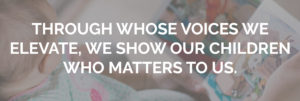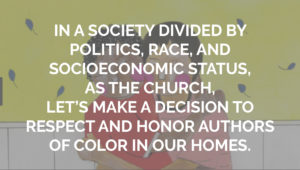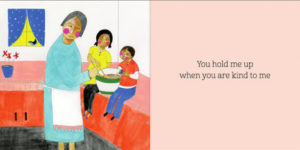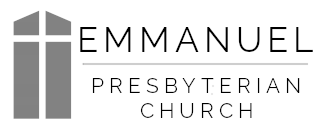Our children see who we listen to, who’s story we tell, who’s books we read.

In a society that has historically privileged white (especially male) authors and perspectives, it is very powerful to intentionally seek out and listen to the voices of people who have been marginalized and ignored.
Recently, my husband, Jared, bought a handful of books written and illustrated by indigenous people and people of color for our daughter, Clementine. They have been some of the most enriching books we have ever had the pleasure of sharing with her.
One of them, our family’s favorite, “You hold me up” by Monique Gray Smith and Danielle Daniels says
you hold me up when you listen to me,
you hold me up when you respect me,
you hold me up when you are kind to me.
It ends with,
You hold me up, I hold you up. We hold each other up.

It is a small act of reconciliation to do so.
In this way, we can model for our children that we view the voices of people of color as being as important and as worthy of our attention and time as the white authors that we traditionally read to our children.
Take a look through your bookshelf at home, see who wrote the majority of the books.
Is your bookshelf dominated by white authors?
I believe as Christians we are called to the work of racial reconciliation and dismantling the ways that our current system oppresses certain groups of people.
One step towards this end is taking the time to diversify the media that we consume and to hear a variety of narratives around what it means to be a person, a family member, and a member of society. Hearing an alternative narrative allows us to understand a little bit about what it feels like to be situated in a different group in the social landscape of America.
Most children’s books that are written by white people include white characters and reinforce being “white” as being “normal” and being anything else as “strange and “other”. Or, even worse, often, white representations of indigenous groups do not accurately represent the values or cultures of these groups.
According to Debbie Reese, Nambe Pueblo, of American Indians in Children’s Literature,
Most of what kids see in books today are best sellers & classics that stereotype & misrepresent Native people in history. There’s a lot of bias in them.
Reading books written by marginalized people about their own culture and experiences goes a long way to widen our view of what is “normal”, “acceptable”, “beautiful” and “true.”
This also allows us to understand how these groups want to be represented.
Rebecca Geinapp adds
when an author shares an identity with the characters they’re creating, the author is more likely to make an authentic representation.
Here is a fantastic list of children’s books by indigenous authors
Here is another great list of books by diverse authors
In the words of Monique Gray Smith and Danielle Daniels, we hold each other up when we listen to each other.





Right on> Lots of things I never thought about. Thanks for the wake up call. Love,Moira
This is so thoughtful, Rachel. I’m reading this after a week of attending a spanish language school here on the Yuccatan peninsula (and feeling oh so white and privileged)- and blown away by the hard work and determination of the workers I see laboring (literally) all around me. We are making friends with the staff at the hotel, and their kindness astounds me. Their hopes and dreams for their children are like us all. I hope and pray we find ways to be more inclusive at our church, and I am grateful to have you and other leaders at the church help us open our eyes and minds to the richness of getting out of our bubbles. If we can do this with our children, it is a great step. (From the Center of Action and Contemplation: today I read today ” …diversity is not our enemy, but our teacher; not something to disdain, but to embrace. —Vanessa Guerin,)